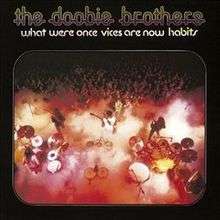What Were Once Vices Are Now Habits
| What Were Once Vices Are Now Habits | ||||
|---|---|---|---|---|
 | ||||
| Studio album by The Doobie Brothers | ||||
| Released | February 1, 1974 | |||
| Recorded | 1973 at Warner Bros. Studios, North Hollywood, CA, Wally Heider Studios, San Francisco, CA, and Burbank Studios, Burbank, CA | |||
| Genre | Rock | |||
| Length | 44:29 | |||
| Label | Warner Bros. | |||
| Producer | Ted Templeman | |||
| The Doobie Brothers chronology | ||||
| ||||
| Singles from What Were Once Vices Are Now Habits | ||||
|
||||
| Professional ratings | |
|---|---|
| Review scores | |
| Source | Rating |
| Allmusic | |
| Robert Christgau | C-[2] |
| Rolling Stone | (mixed)[3] |
What Were Once Vices Are Now Habits is the fourth studio album by American rock band The Doobie Brothers, released in 1974.
Recording and content
Tom Johnston's "Another Park, Another Sunday" was chosen to be the album's first single. "It's about losing a girl," stated Johnston. "I wrote the chords and played it on acoustic, and then Ted [Templeman] had some ideas for it, like running the guitars through Leslie speakers." The song did moderately well on the charts, peaking at #32.
The second single released was "Eyes of Silver", another Johnston penned tune. According to him, "Wordwise, that one really isn't that spectacular. I wrote them at the last minute." That song didn't have much success on the charts either. Grasping for chart action, Warner Brothers re-released the band's first single, "Nobody". This release was soon overshadowed when radio stations discovered "Black Water". Other stations joined in and the song was officially released as a single that went on to sell over a million copies and became the Doobie Brothers' first #1 hit.[4] Ironically, "Black Water" had been featured as the B-side of "Another Park, Another Sunday" eight months earlier.
Artwork
The unusual lettering on the album cover was suggested by drummer John Hartman after visiting his high school alma mater, J.E.B. Stuart in Falls Church, Virginia. The School's newspaper, Raiders Digest, had just changed its masthead to include those stylized fonts. The cover photo is by Dan Fong, their touring "Media Coordinator". He also did the cover photo for their album Takin' It to the Streets. (Source: KCFR, NPR Interview, Denver, Dec. 2, 2014)
Track listing
Side one
- "Song to See You Through" (Johnston) – 4:06
- "Spirit" (Johnston) – 3:15
- "Pursuit on 53rd St." (Johnston) – 2:33
- "Black Water" (Simmons) – 4:17
- "Eyes of Silver" (Johnston) – 2:57
- "Road Angel" (Hartman, Hossack, Johnston, Porter) – 4:49
Side two
- "You Just Can't Stop It" (Simmons) – 3:28
- "Tell Me What You Want (And I'll Give You What You Need)" (Simmons) – 3:53
- "Down in the Track" (Johnston) – 4:15
- "Another Park, Another Sunday" (Johnston) – 4:27
- "Daughters of the Sea" (Simmons) – 4:29
- "Flying Cloud" (Porter) – 2:00
On the back cover, the tracks were listed in alphabetical order instead.
Personnel
The Doobie Brothers:
- Tom Johnston – guitars, vocals
- Patrick Simmons – guitar, vocals
- Tiran Porter – bass, vocals
- John (Little John) Hartman – drums
- Michael Hossack – drums[5]
Additional Musicians:
- Keith Knudsen – backing vocals
- Jeff "Skunk" Baxter – guitar, pedal steel, steel guitar
- James Booker – piano on "Down In The Track"
- Arlo Guthrie – autoharp, harmonica
- Eddie Guzman – conga, timbales, and other percussion instruments
- Jack Hale – trombone
- Milt Holland – tabla, marimba, pandeiro, and other percussion instruments
- Wayne Jackson – trumpet
- Andrew Love – tenor saxophone
- James Mitchell – baritone saxophone
- Novi Novog – viola on "Black Water"
- Bill Payne – keyboards
- Ted Templeman – percussion
Production
- Producer: Ted Templeman
- Production Coordination: Benita Brazier, The Doobie Brothers
- Engineer: Lee Herschberg, Donn Landee
- Mastering: Lee Herschberg
- Horn Arrangements: Andrew Love, The Memphis Horns, Wayne Jackson
- Cover Design: Chas Barbour
- Art Direction: Chas Barbour
- Photography: Dan Fong
Charts
Album
| Year | Chart | Position |
|---|---|---|
| 1975 | Pop Albums | 4 |
Singles
| Year | Single | Chart | Position |
|---|---|---|---|
| 1974 | "Another Park, Another Sunday" | U.S. Pop Singles | 32 |
| 1974 | "Another Park, Another Sunday" [6] | New Zealand (Listener) | 18 |
| 1974 | "Eyes of Silver" | U.S. Pop Singles | 52 |
| 1975 | "Black Water" | U.S. Pop Singles | 1 |
References
- ↑ What Were Once Vices Are Now Habits at AllMusic
- ↑ Christgau, Robert. "The Doobie Brothers: What Were Once Vices Are Now Habits". Robert Christgau.com. Retrieved September 10, 2012.
- ↑ Rolling Stone magazine review
- ↑ "Old Black Water Keep on Rollin': 30 Years of the Doobie Brothers". Long Train Runnin': The Doobie Brothers 1970 - 2000 (CD Booklet). The Doobie Brothers. Warner Bros. Records. 1999. p. 20. 75876.
- ↑ New second drummer Keith Knudsen replaced Hossack during the recording of Vices. Hossack was thus credited as a guest musician on the back of the album, even though he had played drums throughout the recording sessions. The front and back covers of the album show concert photographs taken from behind the group, which makes it difficult to tell which drummers are seen; they are in fact Knudsen and Hartman, photographed on tour while the album was in production. Knudsen's only actual musical contribution to the album was to sing backing vocals.
- ↑ http://www.flavourofnz.co.nz/index.php?qpageID=search%20listener&qartistid=868#n_view_location